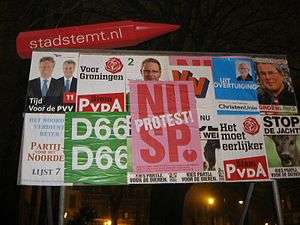Dutch provincial elections, 2011

![Azure, billetty Or a lion with a coronet Or armed and langued Gules holding in his dexter paw a sword Argent hilted Or and in the sinister paw seven arrows Argent pointed and bound together Or. [The seven arrows stand for the seven provinces of the Union of Utrecht.] The shield is crowned with the (Dutch) royal crown and supported by two lions Or armed and langued gules. They stand on a scroll Azure with the text (Or) "Je Maintiendrai" (French for "I will maintain".)](../I/m/State_coat_of_arms_of_the_Netherlands.svg.png) |
| This article is part of a series on the politics and government of the Netherlands |
|
|
Local government |
|
Provincial elections were held in the Netherlands on Wednesday 2 March 2011. Eligible voters elected the members of the States-Provincial in the twelve provinces. These elections also indirectly determined the members of the Senate, since the 566 members of the twelve States-Provincial elected the Senate's 75 members in the Senate election on 23 May 2011.
The Senate election, and therefore the provincial elections, were important since the First Rutte cabinet had a minority in the Senate when it took office. The coalition and support parties hoped to gain a majority in the Senate through these elections, but failed to do so, obtaining 37 out of 75 seats. However, it was expected that the small Christian party SGP, which obtained one seat, would support the cabinet.[1]
On the same date, Island Council elections were held in the three public bodies of the Caribbean Netherlands. It was planned that the members of the Island Councils would also have a vote in the Senate election in the future, but in 2011 this was not yet the case because this required a change in the Constitution.
Results
The right-liberal People's Party for Freedom and Democracy, left-liberal D66, and right-wing Party for Freedom made significant gains throughout the provinces. The Labour Party stayed relatively stable, while the Socialist Party suffered losses from their 2007 results. The Christian Democratic Appeal suffered big losses, losing some 65 of their previous 151 provincial seats. However, the party didn't fare as bad as the polls had suggested.
This was the first provincial elections that Geert Wilders' Party for Freedom participated in. The party managed to win seats in all of the Netherlands' provinces with its best results in the southern provinces of North Brabant and Limburg. In Limburg it even managed to become the biggest party by a slim margin.
National Results
| States-Provincial | ||||
|---|---|---|---|---|
| Political parties | 2007 | 2011 | difference | |
| People's Party for Freedom and Democracy (VVD) | 102 | 112 | +10 | |
| Labour Party (PvdA) | 114 | 107 | -7 | |
| Christian Democratic Appeal (CDA) | 151 | 86 | -65 | |
| Party for Freedom (PVV) | 0 | 69 | +69 | |
| Socialist Party (SP) | 83 | 56 | -27 | |
| Democrats 66 (D66) | 9 | 42 | +33 | |
| GreenLeft (GL) | 33 | 34 | +1 | |
| ChristianUnion (CU) | 35 | 23 | -12 | |
| Reformed Political Party (SGP) | 13 | 12 | -1 | |
| 50PLUS | 0 | 9 | +9 | |
| Party for the Animals (PvdD) | 8 | 7 | -1 | |
| CU-SGP[2] | 3 | 1 | -2 | |
| Regionalist parties:[3] | 13 | 8 | -5 | |
| Frisian National Party (FNP) | 5 | 4 | -1 | |
| Party for Zeeland (PvZ) | 2 | 2 | 0 | |
| Seniorparty North Holland (ONH) - United Senior Party (VSP) | 1 | 1 | 0 | |
| Party for the North (PvhN) | 1 | 1 | 0 | |
| Party New Limburg (PNL) | 1 | 0 | -1 | |
| Beautiful Utrecht | 1 | 0 | -1 | |
| other parties | 2 | 0 | -2 | |
| totals | 564 | 566 | +2 | |
| voters | 46.4 % | 56.0 % | +9.6 % | |
Due to population growth in Gelderland, the number of seats in the States of Gelderland increased from 53 to 55, accounting for the increase in the total number of seats from 564 to 566.
References
- ↑ Trouw, Kabinet kan door met gedoogsteun van SGP
- ↑ Combined list in two provinces (North Holland and North Brabant).
- ↑ Many linked to the Independent Senate Group (OSF).
External links
- Provinciale Statenverkiezingen 2011 States-Provincial Election 2011 from NRC Handelsblad (Dutch)